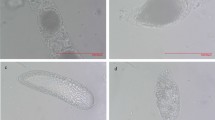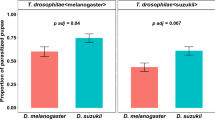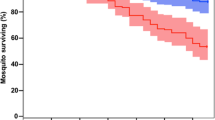Abstract
THE rabbit flea, Spilopsyllus cuniculi, is entirely dependent for its own reproduction on its host becoming pregnant; it has been postulated that a factor, required by the flea for ovarian development, is only present during the last week of host pregnancy1,2. It has also been shown that the corticosteroids and oestradiol stimulate maturation of the ovaries and accelerate the rate of defecation3. These findings suggested the possibility that reproductivity might be increased in blood sucking insects, such as tsetse flies, if the females were fed on pregnant hosts.
This is a preview of subscription content, access via your institution
Access options
Subscribe to this journal
Receive 51 print issues and online access
$199.00 per year
only $3.90 per issue
Buy this article
- Purchase on Springer Link
- Instant access to full article PDF
Prices may be subject to local taxes which are calculated during checkout
Similar content being viewed by others
References
Mead-Briggs, A. R., and Rudge, A. J. B., Nature, 187, 1136 (1960).
Mead-Briggs, A. R., J. Exp. Biol., 41, 371 (1964).
Rothschild, M., Endeavour, 24, No. 93, 162 (1965).
Nash, T. A. M., Kernaghan, R. J., and Boyle, J. A., Ann. Trop. Med. Parasit., 60, 39 (1966).
Author information
Authors and Affiliations
Rights and permissions
About this article
Cite this article
NASH, T., JORDAN, A. & BOYLE, J. Effect of Host Pregnancy on Pupal Production by the Tsetse Fly. Nature 212, 1581–1582 (1966). https://doi.org/10.1038/2121581b0
Published:
Issue Date:
DOI: https://doi.org/10.1038/2121581b0
This article is cited by
Comments
By submitting a comment you agree to abide by our Terms and Community Guidelines. If you find something abusive or that does not comply with our terms or guidelines please flag it as inappropriate.



